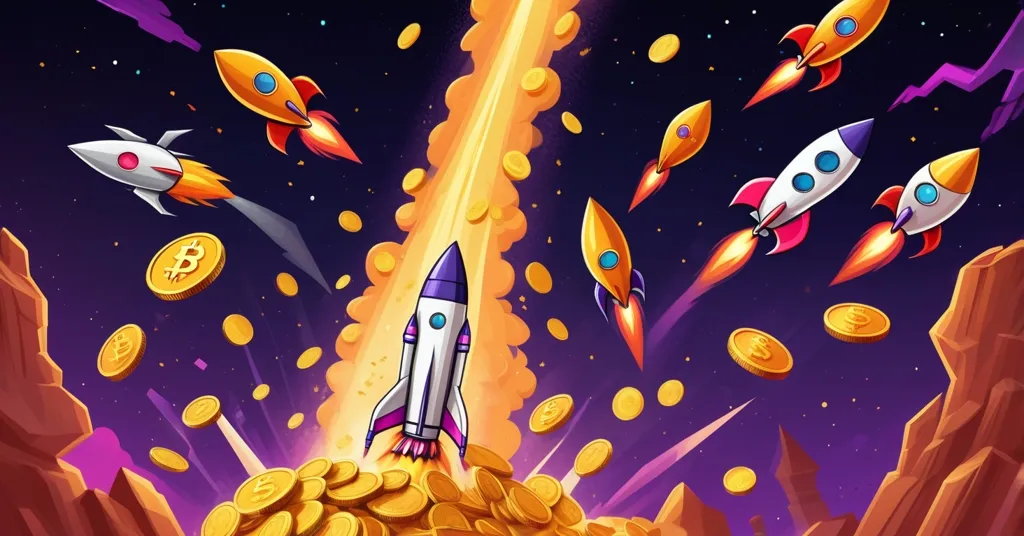Solana dApps Surge to $2.8B Revenue, Outpacing All Rivals Combined

Solana’s dApp Ecosystem Outshines Rivals with $2.8 Billion in Revenue
In the fast-paced world of blockchain, Solana’s decentralized applications (dApps) have surged ahead, amassing a whopping $2.8 billion in revenue over the past year. This figure dwarfs the earnings of dApps on all other networks combined, highlighting Solana’s dominance in the space. But what fuels this success, and can Solana keep its lead amidst the crypto market’s notorious volatility?
- $2.8 billion in revenue for Solana dApps
- 47% more than all other chains combined
- Peaked at $701 million in January, dropped to $146 million by March
- Pump.fun and Jupiter lead the charge
Solana’s dApps are crushing the competition, but don’t get too comfy—the crypto rollercoaster waits for no one. Trading-related applications write the success story of Solana’s dApps, with revenue soaring to dizzying heights of $701 million in January, only to plummet to a mere $146 million by March. This stark swing mirrors the volatility tied to trading volumes and asset prices, which are the lifeblood of these dApps. Trading volumes refer to the total number of assets traded, while asset prices are the values at which these assets are bought and sold.
Among the standout performers, Pump.fun, a memecoin launchpad (a platform for launching new cryptocurrencies), topped the charts in March, raking in $31 million. Not far behind, Axiom, another memecoin launchpad backed by the prestigious Y Combinator, captured 29% of the memecoin dApp market, generating $19 million. On the decentralized exchange (DEX) front, Jupiter, which dominates with 93% of total DEX revenue, earned $22 million in March. Kamino Finance also held its ground, maintaining consistent results alongside Jupiter.
Solana’s allure lies in its low fees and user-friendly infrastructure, making it a magnet for both developers and users. Imagine if sending money was as easy and cheap as sending an email—that’s what Solana aims to achieve with its low fees and fast transactions. The platform’s focus on scalability and affordability has been a key driver of its rapid growth. However, the volatility in earnings remains a challenge. As trading volumes and asset prices fluctuate, so too does the revenue of Solana’s dApps. This is a familiar tale in the crypto world, where the highs can be exhilarating, but the lows can be brutal.
Despite these challenges, Solana’s future looks bright. Its strong ecosystem of token launch platforms and competitive DEXs, coupled with a retail-first focus and low transaction costs, positions it well for continued success. The emergence of new technologies like app-specific chains and AI tools in decentralized finance (DeFi) could further enhance Solana’s ecosystem, potentially driving even more innovation and growth. Jason Lau, Chief Innovation Officer at OKX, notes, “Solana’s DEX growth is driven by its retail-first focus and low transaction costs. The role of aggregators like Jupiter in consolidating liquidity and driving user adoption cannot be understated.”
Yet, it’s not all smooth sailing. The dApp space is fiercely competitive, and while Solana leads today, other blockchains like Ethereum and BSC are not standing still. They bring their own strengths to the table, with Ethereum’s robust smart contract capabilities and BSC’s low-cost transactions. Moreover, the global shift in developer activity towards Asia, now contributing 32% of active developers, adds another layer of complexity to the equation.
From a Bitcoin maximalist perspective, Solana’s success is a double-edged sword. On one hand, it showcases the potential of blockchain technology beyond Bitcoin, pushing the boundaries of what’s possible in decentralized finance. On the other hand, it raises questions about the sustainability of such rapid growth and the potential risks of relying heavily on trading-related dApps. Bitcoin maximalists might argue that while Solana’s innovations are impressive, the true value of cryptocurrencies lies in their scarcity and security, attributes that Bitcoin champions.
So, what can we take away from Solana’s meteoric rise?
- What is the total revenue generated by Solana dApps in the last 12 months?
Solana dApps generated $2.8 billion in revenue over the last 12 months.
- How does Solana’s dApp revenue compare to other blockchain networks?
Solana’s dApp revenue was 47% higher than the combined revenue of dApps on all other blockchain networks.
- When did Solana dApp earnings start outpacing other chains?
Solana dApp earnings began outpacing other chains in October of the previous year.
- What factors contribute to the volatility of Solana’s dApp revenue?
The volatility of Solana’s dApp revenue is primarily driven by trading volumes and asset prices, with revenue peaking and declining in correlation with these factors.
- Which dApp was the top earner on Solana in March?
Pump.fun was the top-earning dApp on Solana in March, generating $31 million.
- What is the market share of Axiom in the memecoin dApp market on Solana?
Axiom captured 29% of the memecoin dApp market on Solana.
- What percentage of total DEX revenue on Solana did Jupiter earn?
Jupiter earned 93% of the total DEX revenue on Solana.
- Why is Solana attractive to developers and users?
Solana is attractive due to its low fees and focus on user experience for end users, as well as its accessible and developer-friendly infrastructure for developers.
Solana’s success is a testament to the power of innovation and the relentless drive to disrupt the status quo. But as any seasoned crypto enthusiast knows, the only constant in this space is change. So, while we celebrate Solana’s achievements, we must also keep an eye on the horizon, ready to embrace the next wave of decentralized technologies that will shape the future of finance.



